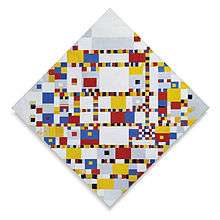Miller Company Collection of Abstract Art
 | |
| Artist | Piet Mondrian |
|---|---|
| Year | 1942–44 |
| Type | Oil and paper on canvas |
| Dimensions | 127 cm × 127 cm (50 in × 50 in) |
| Location | Gemeentemuseum, The Hague. Formerly owned by Samuel Irving Newhouse, Jr. and Emily and Burton Tremaine / The Miller Company Collection of Abstract Art, Meriden, CT. |
The Miller Company Collection of Abstract Art (c. 1945-55) was formed in Meriden, Connecticut as part of the Miller Company. The collection was formed by then-CEO Burton Tremaine, Sr. and his wife/Miller Co. art director Emily Hall Tremaine in c. 1945. The collection itself is most noted for its Painting toward architecture exhibition, originating at the Wadsworth Atheneum in Hartford, CT, and travelling to 24 additional venues in 1947–52.[1]
Painting toward architecture exhibition
After the exhibition's opening at the Wadsworth Atheneum in Hartford, CT, the exhibition travelled to venues across the United States including the Walker Art Center in Minneapolis, the Milwaukee Art Institute (now museum), the Cincinnati Art Museum, the Los Angeles County Museum of Art as well as university gallery venues. The exhibition featured and referred to the leading Modernists in American and European art and architecture with a connection to then-Miller Company lighting designs. Artworks in the Meriden-based collection included those by Picasso, Braque, Gris, Mondrian, Jose de Rivera, Rufino Tamayo, and Stuart Davis, with photographs on Modern architecture design by Le Corbusier, Walter Gropius (Bauhaus), Oscar Niemeyer, Frank Lloyd Wright, and Mies van der Rohe. The catalogue was edited by Henry-Russell Hitchcock; Alfred H. Barr, Jr., director of the Museum of Modern Art in New York, wrote the foreword. [1][2]
Through its run, the travelling exhibition received substantial national media coverage and deepened a discussion on Modern art and architecture in the United States.[1]
Other Modernist design activity at the Miller Company
During this time, as part of a wider Modernist agenda, Miller Co. activities included Philip Johnson closely consulting on product design for the company for at least a three-year period[3] Josef Albers, formerly at the internationally influential Bauhaus in Germany, was hired to work on the corporate logo; and Serge Chermayeff to redesign all the stationary. Around 1955, Emily Hall Tremaine collaborated with influential architect Frank Lloyd Wright on textile designs, with five in the Cooper-Hewitt, Smithsonian Design Museum collection in New York.[4]
Corporate art activity privatized (after c. 1955)
By the mid-1950s, the growing art collection was privatized to the Tremaines,[1] and their art/design decision-making activities took place in Meriden; Madison, CT; New York City and beyond.
Part of the international avant-garde, the Tremaines were in contact with several visual artists and decision-makers now spotlighted in 20th century art and design survey books. In their later work, officially prviate and not collected to the Miller Company, they developed a strong reputations as important art collectors of art from the 1960s, and they continued collecting in the 1970s. In the later decade, they offered land that they partly owned on their Arizona ranch to Walter de Maria to test his now-iconic Lightning Field, a 1-mile x 1 km earthwork designed to attract lightning into an art performance with metal poles, before its relocation to New Mexico.[1]
"By the early 1980s the Tremaine collection had grown to more than 400 works by European and American artists", reported the New York Times,[5] and it was "considered by museum directors, dealers and art writers to be one of the greatest private collections of 20th century art in the world", reported the Hartford Courant.[6] The collection was estimated to be worth USD$84 million in 1987.[1] In 2015 dollars, this amount can be very roughly estimated at over USD$150 million.[7]
President Obama photographed with former Miller Co. star artwork
In 2014, U.S. President Barack Obama was photographed in front of one of the artworks formerly in the Miller Company Collection of Abstract Art, Victory Boogie Woogie by Piet Mondrian, at its current location in the Netherlands. The artwork is also on the cover of a biography on Emily Hall Tremaine. The painting was sold in 1998 for USD$40 million.[8][9]
References
- 1 2 3 4 5 6 Housley, Kathleen L. (2001). Emily Hall Tremaine: Collector on the Cusp. Emily Hall Tremaine Foundation: Meriden, CT.
- ↑ (2016)."The Painting toward architecture exhibition (1947-52) by the Miller Company Collection of Abstract Art". artdesigncafe.com. Retrieved September 18, 2016.
- ↑ Schieps, Marguerite T. (1995), The Miller Company: The first 150 years. (Research: Allen L. Weathers, curator, Meriden Historical Society.) Studley Press, pp. 89-91.
- ↑ (Undated). "Objects that Frank Lloyd Wright and Mrs. Burton Tremaine both worked on". Cooper-Hewitt, Smithsonian Design Museum collection, New York, website. Retrieved July 19, 2015.
- ↑ Fowler, Glenn. (March 27, 1991). Burton G. Tremaine, Executive, 89, Dies; A Collector of Art. New York Times. Retrieved July 10, 2015.
- ↑ Rizzo, Frank. (November 3, 1991). Tremaine Collection Going To Auction: Bidding A Fond Farewell Gavel To Signal End Of An Era. Hartford Courant. Retrieved July 10, 2015.
- ↑ Measuring worth website (historical). Retrieved July 19, 2015.
- ↑ (March 25, 2014). "President Obama ends NSS 2014 with visit to Victory Boogie Woogie". Gemeente Museum Den Haag website. Retrieved August 1, 2016.
- ↑ (October 13, 1998). "Dutch ministers chastised for purchase of $40 million painting". Hurriyet Daily News website. Retrieved August 27, 2016.